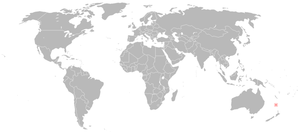
Cyathea brownii
Encyclopedia
Cyathea brownii, commonly known as the Norfolk tree fern or smooth tree fern, is probably the largest tree fern
species in the world. An endemic of Norfolk Island
, in the wild it is reported to reach 20 m (67 ft) or more in height. The broad, lance shaped, bipinnate-pinnatifid to tripinnate frond
s can reach 5 m (17 ft.) in length. Stipe is long and has a line of white, stitch like dashes along its length. Rachis and stipe are covered in white-brown and darker orange-brown scales. The trunk can become smooth with age and may display oval scars left from fallen fronds. It is named after the botanist Robert Brown
(1773-1858).
 Cyathea brownii is endemic to Norfolk Island
Cyathea brownii is endemic to Norfolk Island
in the Pacific Ocean
close to Australia
and New Zealand
.
Cyathea brownii occurs naturally in subtropical rainforest on Norfolk Island. Average daytime temperatures reach around 23 °C during the summer months falling to around 17 °C during the winter. The highest temperatures likely to be experienced in this environment are around 29 °C, the lowest around 6 °C. Relative humidity is fairly consistent at levels between 70 and 80% throughout the year. Yearly rainfall is approximately 1200 mm.
are now reduced to a single small forested area which has been designated part of a national park
. Cyathea brownii is protected within this park. It is available in cultivation in many countries and though rare is not considered endangered.
Cyatheales
The order Cyatheales is a taxonomic division of the fern subclass, Cyatheatae, which includes the tree ferns. No clear morphological features characterize all of the Cyatheales, but DNA sequence data indicates that the order is monophyletic. Some species in the Cyatheales have tree-like growth...
species in the world. An endemic of Norfolk Island
Norfolk Island
Norfolk Island is a small island in the Pacific Ocean located between Australia, New Zealand and New Caledonia. The island is part of the Commonwealth of Australia, but it enjoys a large degree of self-governance...
, in the wild it is reported to reach 20 m (67 ft) or more in height. The broad, lance shaped, bipinnate-pinnatifid to tripinnate frond
Frond
The term frond refers to a large, divided leaf. In both common usage and botanical nomenclature, the leaves of ferns are referred to as fronds and some botanists restrict the term to this group...
s can reach 5 m (17 ft.) in length. Stipe is long and has a line of white, stitch like dashes along its length. Rachis and stipe are covered in white-brown and darker orange-brown scales. The trunk can become smooth with age and may display oval scars left from fallen fronds. It is named after the botanist Robert Brown
Robert Brown (botanist)
Robert Brown was a Scottish botanist and palaeobotanist who made important contributions to botany largely through his pioneering use of the microscope...
(1773-1858).
Habitat and distribution

Norfolk Island
Norfolk Island is a small island in the Pacific Ocean located between Australia, New Zealand and New Caledonia. The island is part of the Commonwealth of Australia, but it enjoys a large degree of self-governance...
in the Pacific Ocean
Pacific Ocean
The Pacific Ocean is the largest of the Earth's oceanic divisions. It extends from the Arctic in the north to the Southern Ocean in the south, bounded by Asia and Australia in the west, and the Americas in the east.At 165.2 million square kilometres in area, this largest division of the World...
close to Australia
Australia
Australia , officially the Commonwealth of Australia, is a country in the Southern Hemisphere comprising the mainland of the Australian continent, the island of Tasmania, and numerous smaller islands in the Indian and Pacific Oceans. It is the world's sixth-largest country by total area...
and New Zealand
New Zealand
New Zealand is an island country in the south-western Pacific Ocean comprising two main landmasses and numerous smaller islands. The country is situated some east of Australia across the Tasman Sea, and roughly south of the Pacific island nations of New Caledonia, Fiji, and Tonga...
.
Cyathea brownii occurs naturally in subtropical rainforest on Norfolk Island. Average daytime temperatures reach around 23 °C during the summer months falling to around 17 °C during the winter. The highest temperatures likely to be experienced in this environment are around 29 °C, the lowest around 6 °C. Relative humidity is fairly consistent at levels between 70 and 80% throughout the year. Yearly rainfall is approximately 1200 mm.
Conservation
The once extensive forests of Norfolk IslandNorfolk Island
Norfolk Island is a small island in the Pacific Ocean located between Australia, New Zealand and New Caledonia. The island is part of the Commonwealth of Australia, but it enjoys a large degree of self-governance...
are now reduced to a single small forested area which has been designated part of a national park
National park
A national park is a reserve of natural, semi-natural, or developed land that a sovereign state declares or owns. Although individual nations designate their own national parks differently A national park is a reserve of natural, semi-natural, or developed land that a sovereign state declares or...
. Cyathea brownii is protected within this park. It is available in cultivation in many countries and though rare is not considered endangered.

